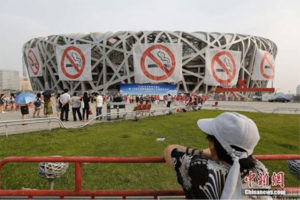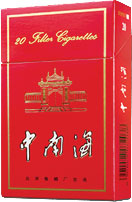On 1 June 2015, Beijing rolled out a new, strict anti-smoking law that placed a ban on smoking in public, including restaurants, offices, and public transport. The regulation also forbids tobacco advertisements and the selling of cigarettes within one hundred metres of primary schools and kindergartens.
China has over 300 million smokers, 1.37 million of whom die from smoking-related illnesses every year, according to 2014 statistics released by the National Health and Family Planning Commission (NHFPC). Yet the fact that new China’s founding fathers such as Chairman Mao and Deng Xiaoping are often seen smoking in photographs and that some cigarette brands boast patriotic names like Zhongnanhai 中南海 (China’s seat of government), cigarettes in China have acquired an almost benign, even revolutionary image. And behind the scenes, concerns about public health have also had to contend with the fact that a government monopoly on tobacco means that cigarette sales contribute directly to state coffers.

The roll out of Beijing’s new anti-smoking law involved a highly visible public awareness campaign, which included draping the iconic Bird’s Nest in anti-smoking signs Source: chinanews.com
While past attempts at banning public smoking in the nation’s capital, most recently during the 2008 Olympics, failed to dent Beijingers’ predilection for lighting up wherever and whenever—partly because the fine was a laughable ten yuan—the new effort appears to be backed by increased resolve. In 2013, the Central Committee of the Communist Party and State Council jointly released regulations banning officials from lighting up in public. Under new legislation, offenders will be fined 200 yuan and businesses that fail to stamp out smoking on their premises could be fined up to 10,000 yuan. Repeat violators will be named and shamed on an official website. Violations can be reported via a call to a government hotline and pictures of offenders can be sent to a public WeChat account. Within a day of the regulations coming into effect, inspectors fined their first offender: a branch of Sichuan Haidiliao 四川海底捞, a popular hotpot chain.
Within a month, health authorities declared the ban’s result ‘satisfactory’, and there appears to be wide adherence to the new law in eateries and bars across the city. But when authorities panned the film, Mr. Six 老炮儿, a runaway success in 2015 that brilliantly captured Beijing’s urban culture, for featuring a smoking scene every 1.3 minutes (the most of any Chinese film in 2015), the director shrugged off criticism: he had, he explained, simply wanted to depict Beijing life accurately.

The motion picture Mr. Six, which was released in September, was noted for featuring a smoking scene every 1.3 minutes Source: cnews.chinadaily.com.cn
Notes
‘Beijing smoking ban claims 1st victim’, China.org.cn, 2 June 2015, online at: http://china.org.cn/china/2015-06/02/content_35715150.htm
Zhang Hui, ‘Smoking ban “satisfactory” ’, Global Times, 4 July 2015, online at: http://www.globaltimes.cn/content/930330.shtml
‘Mr. Six awarded dirty ashtray award: a cigarette every 1.3 minutes’ “老炮儿被颁脏烟灰缸奖:1.3分钟吸一次烟”, Sina.com.cn, 17 May 2015, online at: http://ent.sina.com.cn/m/c/2016-05-17/doc-ifxsenvn7269459.shtml
Cao Siqi, ‘Film producer defends excessive smoking scenes in Mr. Six’, Global Times, 4 January 2016, online at: http://www.globaltimes.cn/content/961636.shtml



